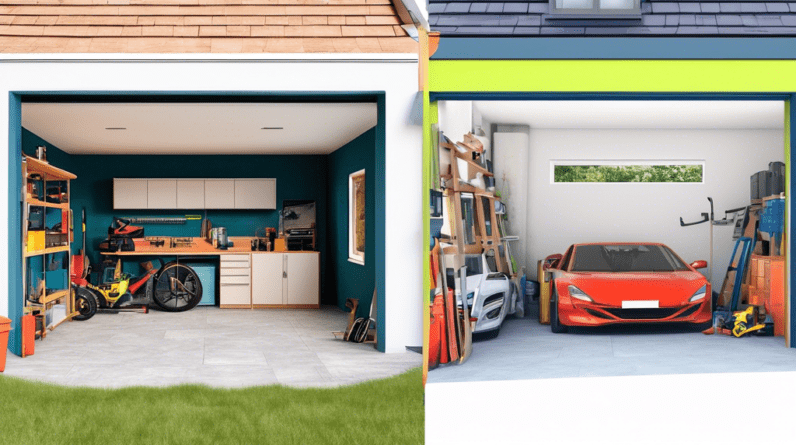
Converting your garage can be a fantastic way to add more living space to your home without the upheaval and expense of moving. Whether you dream of a self-contained apartment, a home office, or a spacious living area, a garage conversion can turn that underutilized space into something extraordinary. However, before you start picking out paint colors and flooring samples, it’s crucial to understand the costs involved in such a project.
Factors Influencing Garage Conversion Costs
The cost of converting a garage can vary wildly depending on a multitude of factors. Understanding these factors will help you estimate your budget more accurately:
1. Size Matters: Square Footage and Its Impact
This one’s a no-brainer: the larger your garage, the more expensive the conversion. A single-car garage conversion will naturally cost less than transforming a spacious double garage. Larger spaces require more materials, labor, and potentially more complex structural changes, all contributing to higher overall costs.
2. Location, Location, Location: Regional Cost Variations
Just like housing prices, construction and labor costs differ significantly across the country. Urban areas or regions with a high cost of living will generally see higher prices for materials and labor compared to more rural areas. Always factor in your local market conditions when budgeting for a garage conversion.
3. From Bare Bones to Luxurious: Scope of the Conversion
Are you envisioning a basic conversion with minimal frills, or do you desire a luxurious space with high-end finishes? The complexity of your project plays a major role in determining the final cost. Basic conversions, such as transforming the garage into a functional living space with standard finishes, will be less expensive than elaborate conversions that require extensive plumbing, electrical upgrades, and custom features.
4. Structural Modifications: Walls, Windows, and More
Converting a garage often involves structural modifications to the existing space. This might include adding or removing walls, installing new windows and doors, reinforcing the foundation, or even raising the roofline. The extent of these structural changes will significantly impact the overall cost of the project.
5. Plumbing and Electrical Work: Essential Considerations
If you plan on adding a bathroom or kitchenette to your converted garage, be prepared for additional expenses related to plumbing and electrical work. Installing new plumbing lines, fixtures, outlets, and wiring can add a substantial amount to your budget.
6. Insulation, Heating, and Cooling: Creating a Comfortable Space
A comfortable living space requires proper insulation, heating, and cooling. The cost of these elements will depend on the climate you live in, the existing insulation levels of your garage, and your desired level of comfort. Adding insulation, ductwork, and HVAC systems can significantly impact your overall expenses.
7. Permits and Regulations: Navigating Local Requirements
Most garage conversions require building permits to ensure that the project meets local building codes and safety standards. Permit fees vary depending on your location and the complexity of your project. It’s crucial to factor in these costs and ensure you obtain all necessary permits before starting any work.
8. Flooring, Fixtures, and Finishes: Adding Your Personal Touch
The final cost of your garage conversion will also depend on your choices for flooring, fixtures, and finishes. From basic laminate flooring to luxurious hardwood, and from standard bathroom fixtures to designer options, your selections will influence the overall price tag. Be sure to allocate a portion of your budget to these essential elements that will bring your vision to life.
Estimating the Average Cost
While providing an exact average cost for a garage conversion is impossible without considering the specific details of your project, here’s a general range to give you a starting point:
Basic Conversion: $5,000 – $15,000
- Minimal structural changes
- Basic insulation and drywall
- Standard electrical outlets and lighting
- Simple flooring options
Mid-Range Conversion: $15,000 – $30,000
- Some structural modifications, such as adding walls or windows
- Upgraded insulation and drywall
- Enhanced electrical work, including additional outlets and lighting fixtures
- Improved flooring choices, such as laminate or tile
- Basic plumbing for a utility sink
High-End Conversion: $30,000+
- Extensive structural changes, including adding a bathroom or kitchenette
- High-quality insulation and finishing touches
- Comprehensive electrical upgrades with custom lighting options
- Premium flooring choices, such as hardwood or natural stone
- Full plumbing for a bathroom and/or kitchenette
- High-end fixtures and appliances
Maximizing Your Investment: Tips for Cost-Effective Conversions
Converting your garage can be a significant investment, but there are ways to keep costs down without compromising on quality:
1. Plan Meticulously: Detailed Planning is Key
A well-defined plan is crucial for staying on budget. Clearly outline your desired outcomes, research materials and contractors thoroughly, and get multiple quotes before starting any work. This meticulous planning will help you avoid costly surprises down the line.
2. DIY Where Possible: Unleash Your Inner Handyman
If you’re handy and comfortable with certain tasks, consider tackling some aspects of the conversion yourself. Painting, demolition, and installing insulation are some areas where DIY efforts can save you money. However, always prioritize safety and leave complex tasks to licensed professionals.
3. Salvage and Repurpose: Embrace Sustainable Practices
Look for opportunities to salvage and repurpose materials from the existing garage or even from other projects. Reclaimed wood, salvaged fixtures, and repurposed doors can add character and uniqueness to your space while reducing waste and saving money.
4. Prioritize Needs Over Wants: Stay Focused on Essentials
While it’s tempting to go all out with luxurious finishes and high-end features, prioritize your needs over wants. Focus on the essential elements that will make the space functional and comfortable, and consider adding luxurious touches later on if your budget allows.
5. Communication is Key: Stay Connected with Your Contractor
Maintain open and honest communication with your contractor throughout the project. Regularly review progress, address any concerns promptly, and stay informed about any potential changes to the scope of work or budget. Effective communication can prevent misunderstandings and costly mistakes.
Conclusion: Creating a Space You’ll Love
Converting your garage can be a fantastic way to enhance your living space and increase the value of your home. While the costs can vary widely, understanding the factors involved and planning meticulously will help you stay on budget and achieve your desired outcome. By carefully considering your options and making informed decisions, you can transform that underutilized space into a valuable and cherished part of your home.






